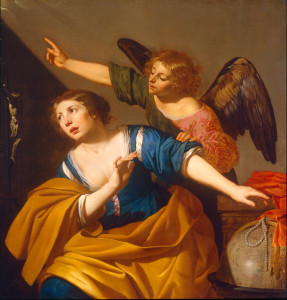Object of the Month: September 2013
St. Mary Magdalene Turning from the World to Christ
Oil on canvas
Jan Hermansz. van Bijlert
Dutch, 1597/98-1671
Mary Magdalene, the penitent sinner, is one of the most popular figures in religious art. Mentioned in all four gospel accounts, Mary followed Christ after He cast seven demons out of her. She witnessed His crucifixion, was present at His burial, was the first to speak with Him following His resurrection, and was sent by Him to tell His apostles that He was no longer dead. Her own story is often confused with other biblical and traditional figures: the sinner of Luke 7 who wiped Christ’s feet with her hair before anointing them with oil, Mary the sister of Martha and Lazarus, and Mary of Egypt (a penitent prostitute who lived as a recluse in the desert).
In art, Mary Magdalene’s symbols are as varied as the stories attributed to her. Most common is her flowing hair and a jar of ointment, referencing the sinner in Luke 7 as well as the anointing of Christ’s body for burial. A skull and book represent her reflection on the transitory nature of life. A crucifix shows her faith in Christ. And even an egg, more common in Eastern art, references her witnessing Christ’s resurrection.
Jan Hermansz. van Bijlert’s St. Mary Magdalene Turning from the World to Christ (1597/98–1671) breaks from more traditional depictions of Mary Magdalene. As a Dutch Baroque portrait painter, van Bijlert reflected the daily life of those who commissioned his work, the rising middle class merchants. Mary Magdalene, one of his few religious subjects, lacks most of Mary’s traditional symbols. Instead, like his portraits, it reflects Dutch middle class fashion. Mary’s dress, hairstyle, and even the objects representing the world that she is rejecting—the globe, fine fabric, and pearls—would have been familiar to the Dutch middle class.
Though the artist’s style is Dutch, his message is universal: no one can follow both Christ and the world. The treasures of the world are on one side of the painting, and the crucified Christ on the other. Christ Himself taught that no one can serve both God and the world (Luke 16:13). Like Mary Magdalene, every person must choose which he or she will follow. As Mary kneels to the crucified Christ, an angel lays his hand on her arm and points upward, possibly to the risen Christ “who is even at the right hand of God, who also maketh intercession for us” (Romans 8:34).
Amy Beach Ruley, former M&G Graduate Assistant
Published in 2013
